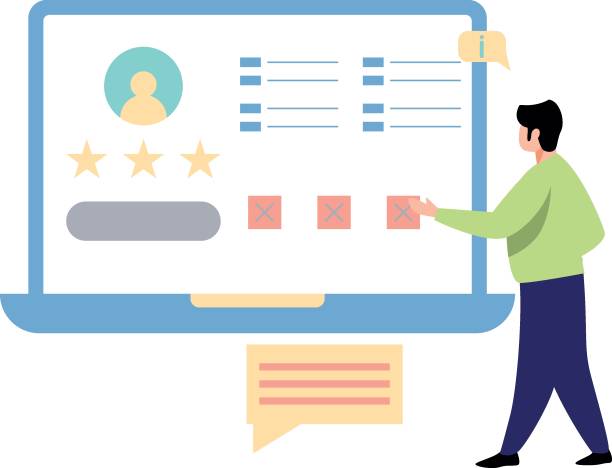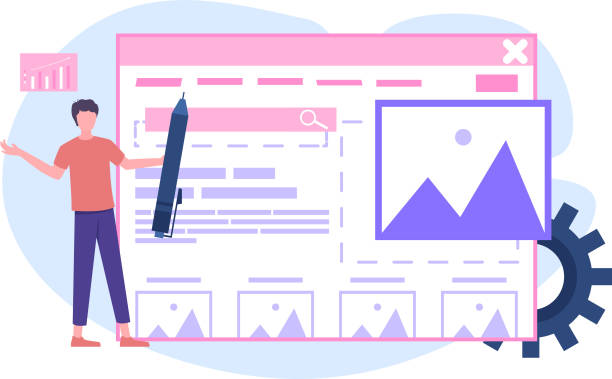The Importance of Entering Global Markets with #Multilingual_Website_Design

In today’s world, where geographical boundaries have lost their meaning in cyberspace, #multilingual_website_design is no longer just a competitive advantage, but an undeniable necessity for any business dreaming of expanding its operations globally.
This type of design allows you to communicate with your audience worldwide in their native language, which is a key factor in building trust and increasing conversion rates.
Imagine having a website that is only available in Persian; in this case, you would lose all non-Persian speaking users.
This is a significant missed opportunity for growth and development.
Multilingual website design enables businesses to penetrate new markets and attract more potential customers.
This not only means increased website traffic but also expanding your brand’s international credibility.
For any business seeking sustainable growth and development, understanding the importance of and investing in website design with multilingual capabilities is a vital and strategic step.
This comprehensive guide will help you familiarize yourself with various aspects of building an effective multilingual website and fully leverage its potential.
Can your business truly experience real and sustainable growth without access to global markets? This is a question every entrepreneur should ask themselves.
Are you tired of your company’s website not meeting your expectations? Design a professional website with Rasawp that showcases the true face of your business.
✅ Increase acquisition of new customers and sales leads
✅ Enhance your brand’s credibility and trust with your audience
⚡ Get a free website design consultation!
Countless Benefits of Multilingual Websites and Their Impact on E-commerce

The benefits of multilingual website design extend beyond simply connecting with new audiences.
These types of websites significantly improve the user experience, which in turn helps increase user dwell time on the site and reduce bounce rates.
When a user can read the site’s content in their native language, they feel more comfortable and trusting, which directly influences their decision to purchase or use your services.
From an SEO perspective, multilingual websites have a higher chance of ranking higher in search engines by expanding the range of keywords and searches in different languages.
This is a strong analytical advantage that allows your website to be seen more in global search results.
These websites also help strengthen your brand’s international credibility; they show that you value your diverse audience and pay attention to their needs.
In the field of e-commerce, multilingual capability can directly impact sales and revenue, as potential customers from different countries can easily browse and purchase your products.
Have you ever considered how a single-language website deprives you of a huge segment of the global market? The answer to this question clarifies the importance of being multilingual.
This is an analytical and explanatory step on the path to success for modern businesses.
Key Considerations in #Multilingual_Website_Design; From Structure to Content

When considering #multilingual_website_design, several key considerations must be carefully examined to ensure your website is not only functional but also effective in every language.
The first step involves #choosing_the_appropriate_URL_structure; will you use subdomains (e.g., en.yourdomain.com), subdirectories (yourdomain.com/en), or top-level domains (yourdomain.com) for each language? Each has its own pros and cons in terms of SEO and management.
Then, the discussion of #choosing_a_Content_Management_System (CMS) arises; does your CMS support multilingual capabilities, or does it require specific plugins? Platforms like WordPress with plugins such as WPML or Polylang, as well as proprietary platforms, can be suitable options.
The most important part is content management.
This includes not only accurate text translation but also content localization, which means adapting the content to the culture and local needs of each region.
For example, currency units, date and time formats, and even images should be adjusted to suit the local audience.
This part of multilingual website design requires a great deal of technical and specialized aspects that need to be carefully planned.
Here, an educational and explanatory approach to better understand these concepts is provided.
Did you know that even small cultural differences can have a big impact on the user experience on a multilingual website?
| Structure Type | URL Example | Advantages | Disadvantages |
|---|---|---|---|
| Subdirectory | example.com/en/ | Strong SEO, easier management | Requires precise structuring |
| Subdomain | en.example.com | Separate authority, local server | Higher cost, more complex SEO |
| Country Code Top-Level Domain (ccTLD) | example.de | High local authority, precise targeting | High cost, complex management |
Choosing a Content Management System (CMS) for Multilingual Website Design
![]()
Choosing a #suitable_Content_Management_System for implementing your #multilingual_website is crucial.
This decision not only affects the #development_process but also impacts your site’s long-term maintenance and SEO capabilities.
Popular CMSs like WordPress, Joomla, and Drupal all offer multilingual capabilities through dedicated plugins or modules.
WordPress, as the most widely used CMS, with plugins like WPML and Polylang, allows for easy management of translations and multilingual content.
These plugins enable you to translate posts, pages, categories, tags, and even menus.
However, CMS selection should be based on the specific needs of the project and expected complexities. For larger projects with more custom requirements, Drupal might be a more powerful option, as it was designed from the ground up for multilingual content management.
Additionally, e-commerce platforms like Shopify or WooCommerce (for WordPress) also have their specific multilingual solutions that are very important for online stores.
This is a specialized topic that requires careful consideration.
An important guide is to do enough research before making a decision and even consult with a multilingual website design consultant to choose the best option for your needs.
Is your current content management system ready to support international growth?
Are you worried about your e-commerce site’s low conversion rate and not getting the sales you desire?
Rasawp is your specialized solution for a successful e-commerce site.
✅ Significant increase in conversion rates and sales
✅ Professional and user-friendly design to satisfy customers
⚡ Ready for a transformation in online sales? Get a free consultation!
SEO for Multilingual Sites; Strategies for Global Visibility

Search Engine Optimization (#SEO) for a #multilingual_site has its own complexities that go beyond single-language site SEO.
One of the most important aspects is the correct use of the #hreflang_tag.
This tag informs search engines like Google which version of a page is intended for which language or geographical region, thus preventing duplicate content issues and helping search engines display the correct version to users in search results.
In addition, #keyword_research must be done separately for each language and region, as keywords and search phrases can vary greatly across different cultures and languages.
Creating #separate_XML_sitemaps for each language is also an effective way to help search engines crawl and index your multilingual content.
Link building and domain authority building in each language are also of high importance. This is a specialized and instructive analysis in the field of SEO.
Explanatory and guiding content in this area can help you ensure that your multilingual website is not only technically correct but also well-visible in search engines and attracts targeted traffic.
Success in multilingual website design heavily depends on adhering to international SEO principles.
Did you know that the smallest mistake in hreflang implementation can lead to SEO penalties?
Content Translation and Localization; Beyond Word-for-Word

Content translation for a #multilingual_website means more than just converting words from one language to another.
#Localization goes beyond this and means #full_adaptation_of_content to the culture, customs, and expectations of local audiences.
This includes changes in tone, style, images, units of measurement, date and time, currency, and even colors and symbols that may have different meanings in different cultures.
For example, a joke or colloquialism in one language might be meaningless or even offensive in another.
A simple machine translation can never replace accurate localization by a professional native translator. This is a critical aspect in multilingual website design that is often overlooked.
Hiring native translators specialized in your business field can make a significant difference in the quality and effectiveness of your multilingual content.
This is an educational and specialized approach that must be carefully considered.
Also, using a #dedicated_glossary and #style_guide is recommended to maintain brand consistency across all languages.
Have you ever thought about how an inaccurate translation can not only damage your brand’s credibility but even lead to serious cultural misunderstandings? This thought-provoking content shows that translation is just the beginning.
User Experience (UX) in Multilingual Website Design; Navigation and Accessibility

#User_Experience (UX) gains double importance in a #multilingual_site.
Users should be able to easily and without confusion switch between different languages and find the content they are looking for.
This includes #designing_a_clear_and_accessible_language_switcher, which is usually placed in the header or footer of the site and displayed as a country flag or language name (e.g., “English” instead of “EN”).
#Site_navigation must be logical and intuitive in every language, and the order of elements and page layout should not confuse the user.
Fonts, text size, and readability should also be optimized for each language, especially for languages with different alphabets (like Persian versus English).
Adhering to web accessibility standards in all languages is also essential to ensure that people with different abilities can use your site. This is a specialized and guiding part of multilingual website design that directly impacts user satisfaction and conversion rates.
A poor user experience can quickly drive users away from your site, even if your content is excellent.
This explanatory content helps you understand the importance of UX.
Have you ever thought about how improper language switcher design can harm the user experience and lose potential customers?
| UX Element | Importance | Optimization Tips |
|---|---|---|
| Language Switcher | Easy access, high discoverability | Use language name (not flag), fixed location (header/footer) |
| Navigation | Smooth and intuitive in all languages | Translated menus, logical structure, avoid clutter |
| Typography | Readability and visual appeal | Choose appropriate fonts for each language, adjust line size and spacing |
| Localized Content | Cultural relevance and prevention of misunderstanding | Use appropriate images, adjust units of measurement and time |
Common Challenges and Solutions in Multilingual Site Implementation

Implementing a successful #multilingual_site is not without challenges.
One of the biggest challenges is #managing_translated_content and updating it across all languages simultaneously.
This can be very time-consuming and complex, especially for sites with a large volume of content.
Choosing a suitable Translation Management System (TMS) can facilitate this process. Another challenge is #maintaining_translation_quality and localization over time.
If new content is added or existing content changes, you must ensure that translations are also correctly updated to maintain consistency and accuracy.
SEO issues, such as problems with the hreflang tag or mistakes in keyword research, can also reduce the site’s visibility in search engines.
Technical challenges related to hosting (such as CDN for faster speeds in different regions) and website performance in distant geographical areas are also important issues that need to be considered.
This is an analytical and guiding content that highlights potential problems.
To overcome these challenges, #comprehensive_planning and the use of #appropriate_tools are essential.
Additionally, having a specialized team in multilingual website design and localization can make a big difference in the success of the project. Is your organization ready to face these challenges and invest in appropriate solutions?
Is your current e-commerce website not generating the sales you expect?
Rasawp specializes in professional e-commerce website design!
✅ An attractive and user-friendly site aimed at increasing sales
✅ High speed and security for an ideal shopping experience⚡ Get a free online store design consultation with Rasawp!
Case Studies and Future Trends in Multilingual Websites

A look at successful #case_studies from companies that have successfully implemented #multilingual_websites can be inspiring.
Large technology and e-commerce companies like Amazon and Google are prime examples of excellent multilingual website design that support millions of users worldwide.
These companies not only provide accurate translations but have also fully localized the user experience for each region.
Studying these news and specialized cases can teach us valuable lessons.
In the future, #new_trends in artificial intelligence and machine learning can automate and further refine the translation and localization process.
The use of advanced #Neural_Machine_Translation (NMT) alongside human editing can increase the speed and efficiency of multilingual content production.
Also, the importance of #voice_SEO in different languages and #Virtual_Reality (VR) and #Augmented_Reality (AR) in multilingual experiences is increasing.
These new trends open new horizons for multilingual website design and show how technology can help expand global access. This is a news and entertaining analysis that outlines the future of multilingual websites.
Is your business ready to embrace these changes and invest in new technologies to stay at the forefront of global competition?
Conclusion and Best Practices for a Successful Multilingual Website

Ultimately, multilingual website design is no longer just a choice, but a strategic necessity for any business looking to grow and expand in #global_markets.
To ensure success, #best_practices include careful planning, choosing a suitable CMS with strong multilingual capabilities, investing in high-quality translation and localization, and accurately implementing international SEO principles.
From selecting the right URL structure to implementing the hreflang tag and optimizing the user experience in each language, every step must be taken with precision and expertise.
Continuous monitoring and analysis of site performance in each language to identify strengths and weaknesses are also essential.
This is a comprehensive and educational guide to conclude the discussion.
Remember that a successful multilingual website is a bridge connecting you to potential customers worldwide, enhancing brand credibility, and ultimately, ensuring your business’s sustainable growth. This is not only a powerful marketing tool but also demonstrates your respect for different cultures and languages.
After all this information, will you still ignore the immense potential of multilingual website design? This explanatory content helps you make an informed decision.
Frequently Asked Questions
| Question | Answer |
|---|---|
| What is multilingual website design? | The process of building a website whose content is available to users in more than one language. |
| Why should I make my site multilingual? | To reach a wider global audience, improve user experience for non-native speakers, and increase sales or engagement. |
| What are the methods for implementing a multilingual site? | Using subdomains, subdirectories, or URL parameters, or using different top-level domains (TLDs) for each language. |
| Which method is better for SEO? | Generally, using subdirectories (like example.com/fa/) is recommended for SEO, as they share the main domain’s authority. |
| What is the hreflang tag and what is its use? | The hreflang tag is an HTML attribute that helps search engines understand which version of a page is suitable for a specific language or region. |
| Is machine translation sufficient for multilingual site content? | Usually no. Professional translation and content localization are essential to provide a good user experience and maintain credibility. |
| What does Localization mean? | The process of adapting content, design, and site functionality to the culture, language, currency, and other specific characteristics of a target region or country. |
| What is the importance of language selection in multilingual website design? | Users should be allowed to easily select their preferred language, usually via a clear button or menu in the site’s header. |
| What challenges exist in multilingual website design? | Managing content in different languages, maintaining consistency in design and user experience, multilingual SEO, and translation and maintenance costs. |
| What features should a suitable Content Management System (CMS) for a multilingual site have? | It should allow easy content management in multiple languages, support multilingual URL structures, and have relevant plugins for translation and localization. |
And other advertising services of Rasawp Advertising Agency
Smart SEO: A combination of creativity and technology for digital branding through user experience customization.
Smart Digital Advertising: An effective tool for attracting customers with engaging UI design.
Smart UI/UX: Designed for businesses looking to increase click-through rates through SEO-focused content strategy.
Smart Digital Advertising: A creative platform for improving digital branding with precise audience targeting.
Smart Data Analysis: A fast and efficient solution for improving SEO ranking by focusing on intelligent data analysis.
And over hundreds of other services in the field of internet advertising, advertising consultation, and organizational solutions
Internet Advertising | Advertising Strategy | Advertorials
? To elevate your business in the digital space, Rasawp Digital Marketing Agency, specializing in secure website design and SEO, is always with you to ensure a powerful and lasting presence in the online world.
📍 Tehran, Mirdamad Street, next to Bank Markazi, Southern Kazeroon Alley, Ramin Alley, No. 6


